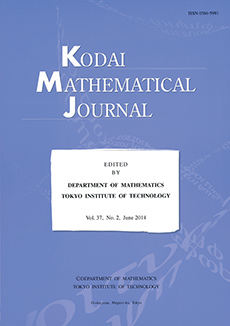Abstract
Let $\{\xi_{n}\}_{n\geq 0}$ denote an ergodic Markov chain with a finite state space $\mbox{\boldmath$\Xi$}=\{1,2,\cdots, s\}$. %with a transition matrix %$Q=(q_{jk})_{j,k\in\mbox{\boldmath$\Xi$}}$. For each $j,k\in\mbox{\boldmath$\Xi$}$, let $\{Y^{jk}_{n}\}_{n\geq 1}$ be a sequence of i.i.d. $\{-1,1\}$-valued random variables which are independent of $\{\xi_{n}\}$. %We assume that %$\{Y^{jk}_{n}\}_{n\geq 1}$ is the %sequence of identically distributed %random variables for each $j,k\in\mbox{\boldmath$\Xi$}$. We define the process $\{S_{n}\}_{n\geq 0}$ by $S_{0}=0$ and $S_{n}=S_{n-1}+Y^{\xi_{n-1}\xi_{n}}_{n}$ for $n\geq 1$. %The process $\{S_{n}\}_{n\geq 0}$ is known as %{\it a random walk defined on a finite %Markov chain}. Let $a$ be a positive integer. % and denote by %$[0,a]$ the interval consisting of the integers %$0,1,2,\cdots, a$. We denote by $T_{x}$ the first exit time of the process from the interval $[-x,a-x]$ for each $x=0,1,\cdots,a$. % $T_{x}=\inf\{n>0|x+S_{n}\notin [0,a]\}$ %for each $x\in [0,a]$. %Set We give an asymptotic behavior of the transition functions %of random walk defined on %a finite Markov chain with absorbing barriers $P_{jk}^{(n)}(x,y) =\mbox{\boldmath$P$}\{x+S_{n}=y; T_{x}>n; \xi_{n}=k |\xi_{0}=j\} % \label{asymptotic} $ as $n\rightarrow\infty$ for each $x,y\in [0,a]$ and all $j,k\in\mbox{\boldmath$\Xi$}$.
Citation
Michio Shimura. Toshiyuki Takenami. "A local limit theorem for random walk defined on a finite Markov chain with absorbing barriers." Kodai Math. J. 25 (3) 301 - 308, October 2002. https://doi.org/10.2996/kmj/1071674463
Information





